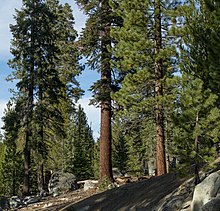bio.wikisort.org - Plant
Abies magnifica, the red fir or silvertip fir, is a western North American fir, native to the mountains of southwest Oregon and California in the United States. It is a high-elevation tree, typically occurring at 1,400–2,700 metres (4,600–8,900 ft) elevation, though only rarely reaching tree line. The name red fir derives from the bark color of old trees.
Description
Abies magnifica is a large evergreen tree typically up to 40–60 metres (130–200 ft) tall and 2 m (6 ft 7 in) trunk diameter, rarely to 76.5 m (251 ft) tall and 3 m (9 ft 10 in) diameter, with a narrow conic crown. The bark on young trees is smooth, grey, and has resin blisters, becoming orange-red, rough and fissured on old trees. The leaves are needle-like, 2–3.5 centimetres (3⁄4–1+1⁄2 in) long, glaucous blue-green above and below with strong stomatal bands, and an acute tip. They are arranged spirally on the shoot, but twisted slightly S-shaped to be upcurved above the shoot.
The cones are erect, 9–21 cm (3+1⁄2–8+1⁄4 in) long, yellow-green (occasionally purple), ripening brown and disintegrating to release the winged seeds in fall.
 |
 |
Varieties
There are two, perhaps three varieties:
- Abies magnifica var. magnifica, red fir – cones 14–21 cm (5+1⁄2–8+1⁄4 in) long, bract scales short, not visible on the closed cones. Most of the species' range, primarily in the Sierra Nevada.
- Abies magnifica var. shastensis, Shasta red fir – cones 14–21 cm (5+1⁄2–8+1⁄4 in) long, bract scales longer, visible on the closed cone; bark 10–15 cm (4–6 in) thick. The northwest of the species' range, in southwest Oregon and Shasta, Siskiyou[2] and Trinity Counties in northwest California.
- A. magnifica on the eastern slopes of southern Sierra Nevada – possibly a third variety, have not been formally named, also having long bracts, and additionally have smaller cones, 9–15 cm (3+1⁄2–6 in) long.
Related
Red fir is very closely related to Abies procera (noble fir), which replaces it further north in the Cascade Range. They are best distinguished by the leaves; noble fir leaves have a groove along the midrib on the upper side, while red fir does not show this. Red fir also tends to have the leaves less closely packed, with the shoot bark visible between the leaves, whereas the shoot is largely hidden in noble fir. Shasta red fir hybridizes with noble fir, with which it is both chemically and microscopically similar;[2] some botanists treat the former as a natural hybrid between red and noble fir.
First recording
This tree was first recorded by William Lobb on his expedition to California of 1849–1853, having been overlooked previously by David Douglas.[3]
Uses
The wood is used for general structural purposes and paper manufacture. It is also a popular Christmas tree.
Paiute peoples used the foliage of Shasta red fir (or perhaps noble fir) to treat coughs and colds.[2]
See also
References
- Farjon, A. (2013). "Abies magnifica". IUCN Red List of Threatened Species. 2013: e.T42290A2970154. doi:10.2305/IUCN.UK.2013-1.RLTS.T42290A2970154.en. Retrieved 19 November 2021.
- Arno, Stephen F.; Hammerly, Ramona P. (2020) [1977]. Northwest Trees: Identifying & Understanding the Region's Native Trees (field guide ed.). Seattle: Mountaineers Books. pp. 143–149. ISBN 1-68051-329-X. OCLC 1141235469.
- Toby Musgrave; Chris Gardner & Will Musgrave (1999). The Plant Hunters. Seven Dials. p. 147. ISBN 1-84188-001-9.
Further reading
- Chase, J. Smeaton (1911). "Abies magnifica (Red-fir, Balsam-fir, Magnificent Silver-fir)". Cone-bearing Trees of the California Mountains. Eytel, Carl (illustrations). Chicago: A.C. McClurg & Co. pp. 72–74. LCCN 11004975. OCLC 3477527.
External links
![]() Media related to Abies magnifica (red fir) at Wikimedia Commons
Media related to Abies magnifica (red fir) at Wikimedia Commons
- USDA Forest Service: Abies magnifica
- CalFlora Database: Abies magnifica
- Gymnosperm Database – Abies magnifica
- Arboretum de Villardebelle: Abies magnifica Photos – group 1
- Arboretum de Villardebelle: Abies magnifica Photos – group 2
На других языках
[de] Pracht-Tanne
Die Pracht-Tanne (Abies magnifica) ist eine Pflanzenart aus der Gattung der Tannen (Abies) in der Familie der Kieferngewächse (Pinaceae).- [en] Abies magnifica
[ru] Пихта великолепная
Пи́хта великоле́пная[1] (лат. Ábies magnífica) — дерево; вид рода Пихта семейства Сосновые (Pinaceae).Другой контент может иметь иную лицензию. Перед использованием материалов сайта WikiSort.org внимательно изучите правила лицензирования конкретных элементов наполнения сайта.
WikiSort.org - проект по пересортировке и дополнению контента Википедии


